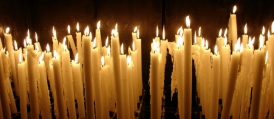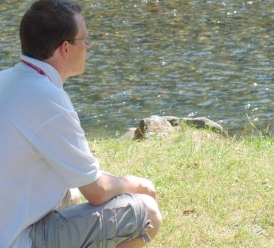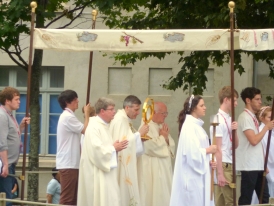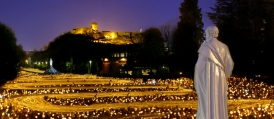
Lighting a candle before the Grotto
One of the great traditions of Lourdes is to light a candle in front of the Grotto. Candles burn there throughout the year and the money from the candles is a major source of income for the Sanctuaries. ‘Light a candle for me at the Grotto,’ is a frequent request from those who cannot come on pilgrimage. Because of the numbers of people in Lourdes at this time it is not practical to actually light your candle to leave burning at the Grotto but you can leave your candles in the trolleys provided and they will be burnt at some time during the next few months. You may wish to use this prayer as you place your candle before the Grotto.
Lord, may this candle be a light for you to enlighten me in my difficulties and decisions.
May it be a fire for you to burn out of me all pride, selfishness and impurity
May it be a flame for you to bring warmth into my heart, towards my family, my
neighbours and all those who meet me.
Through the prayers of Mary, virgin and mother I place in your care those I come
to pray for, especially……………………………………
I cannot stay long in this holy place and in leaving this candle I wish to give to you
something of myself.
Help me to continue my prayer into everything I do during these days of pilgrimage.

A Time for Silence
Lourdes can be very noisy, so it is important that at some stage during the pilgrimage we take time to be still, perhaps in The Tent of Adoration before the Blessed Sacrament or in front of the Grotto.
Sometimes if you cross over to the Prairie and sit on the wall by the river facing the Grotto it can be very still and calm.
Teach us, O God, that silent language which says all things. Teach our souls to remain silent in thy presence: that we may adore thee in the depths of our being and await all things from thee, whilst asking of thee nothing save the accomplishment of thy will.
Teach us to remain quiet under thine action and produce in our souls that deep and simple prayer which says nothing and expresses everything, which specifies nothing and expresses everything.
At the Baths
“Go and drink at the spring and wash in it.”
(Our Lady to Bernadette, Thursday 25th February 1858)
The baths are past the Grotto - about 100 yards - and are divided into two sections, one for men and one for women.
The original spring, which you can see at the back of the Grotto if you go through, now gives around 17,000 gallons of water per day. Two large reservoirs ensure a supply during the dry months. It soon became the custom for pilgrims, especially the sick, to bathe in it and baths were built to make this easier. The present baths were built in 1955 to replace the original ones that were situated where the water taps are now, enabling everyone to heed Our Lady's call.
The baths are open every day, except on Sunday, from 9 00am to 11 00am and from 2 00pm to 4 00pm. On Sundays they open from 2 00pm to 4 00pm. If you wish to go, then get there in good time. The women particularly are likely to encounter lengthy queues. During time at the baths prayers, in particular the Rosary, are said in the different languages.

The Eucharistic Procession
The Procession of the Blessed Sacrament takes place each afternoon at 5 00 p.m. During the pilgrimage we shall be making a special effort to walk together as the Diocesan Family led by our Bishop.
The procession starts from the Podium on the prairie opposite the Grotto and in that area you will find the various diocesan groups gathering together so look out for our diocesan banner. In the event of extreme weather conditions – too hot or too wet – the procession will begin and end in the Underground Basilica.
The procession then moves to the Underground Basilica for a period of Adoration and then the Blessings. You can follow the texts on the big screens and by listening. If you do not wish to walk in the procession you can go immediately to the Underground Basilica to where the outside part of the procession is relayed in sound and vision.
The Diocesan Banner will be carried in procession each afternoon we are in Lourdes.
The refrain: Lauda Sion salvatorem
Lauda ducem et pastorem
in hymnis et canticis
Other hymns and songs are used as well as some prayers in various languages including English. Before the final blessing we join in singing the Tantum ergo.
Tantum ergo sacramentum
Veneremur cernui:
Et antiquum documentum
Novo cedat ritui;
Praestet fides supplementum
Sensuum defectui.
Genitori, genitoque
Laus et jubilatio
Salus, honor, virtus quoque
Sit et benedictio;
Procedenti ab utroque
Compar sit laudatio.
Come adore this wondrous presence
bow to Christ, the source of grace.
Here is kept the ancient promise
of God’s earthly dwelling place.
Sight is blind before God’s glory
faith alone may see his face.
Glory be to God the Father
praise to his co-equal Son,
adoration to the Spirit,
bond of love, in Godhead one.
Blest be God by all creation
joyously whiles ages run.
(St Thomas Aquinas 1227-74)

The Torchlight Procession
Since I872, when a Capuchin priest, Fr Marie Antoine, first organised a procession after he had observed people gathering in prayer with candles, the great evening celebration sets the pace of the life of the Sanctuary, moving along in a popular and festive outburst of singing praise to Our Lady, praying the Rosary and procession. The Torchlight Procession is one of the greatest images of Lourdes. It takes place each evening at 9 00pm and those wishing to take part should try to be in place behind the Diocesan banner by 8 45pm. Try and make a special effort to take part in this procession with all the diocesan group one evening.
The procession begins with the recitation of the Rosary in different languages including English. Whatever language is used the custom is to use your own language in praying the 'Hail Mary' and 'Our Father.'
The Rosary was developed during medieval times as a popular substitute for the set prayers and psalms which made up the Divine Office. It was a simple way for ordinary people to meditate on the main events of the story of Christ. As well as the traditional Joyful, Sorrowful and Glorious Mysteries of the Rosary there are also the ‘Mysteries of Light’ which the late Pope John Paul II introduced in October 2002 in his Apostolic Letter Rosarium Virginis Mariae. As we pray the Rosary we allow ourselves the time to think about each of the Mysteries, letting the richness of their meaning unfold in our hearts and minds.
At the end of the celebration you are asked to keep silence, especially in front of the Grotto.
SALVE REGINA
Salve Regina, Mater Misericordiae;
vita dulcedo, et spes nostra, salve.
Ad te clamamus, exules filii hevae.
Ad te suspiramus, gementes et flentes,
in hac lacrimarum vale.
Eja ergo, Advocata nostra,
illos tuos misericordes oculos
ad nos converte.
Et Jesum benedictum fructum ventyris tui,
nobis post hoc exilium ostende.
O clemens, O pia, O dulcis Virgo Maria
HAIL HOLY QUEEN
Hail Holy Queen, mother of mercy, hail our life,
our sweetness and our hope.
To thee do we cry
poor banished children of Eve.
To thee do we send up our sighs
mourning and weeping in this vale of tears.
Turn then most gracious Advocate thine eyes of mercy
towards upon us and after this our exile
show us the blessed fruit of your womb, Jesus.
O clement, O loving, O sweet Virgin Mary




